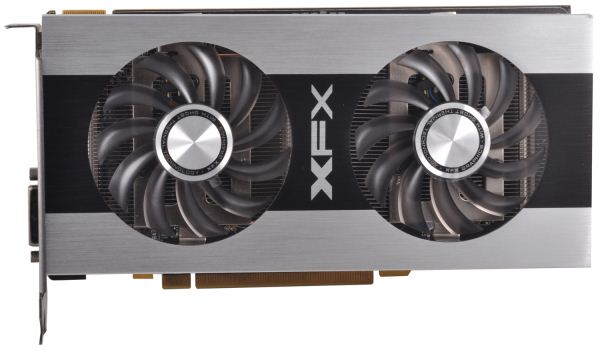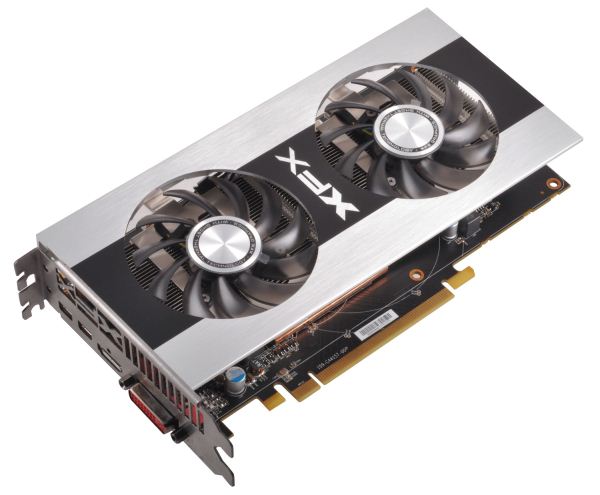AMD Radeon HD 7750 & Radeon HD 7770 GHz Edition Review: Evading The Price/Performance Curve
by Ryan Smith & Ganesh T S on February 15, 2012 12:01 AM EST- Posted in
- GPUs
- AMD
- HTPC
- GCN
- Radeon HD 7000
Meet the XFX R7770 Black Edition S Double Dissipation
Our final card of the day is XFX’s R7770 Black Edition S Double Dissipation, one of a multitude of Radeon HD 7770 cards XFX will be releasing today. XFX will be releasing two factory overclocked Black Edition cards today, with the S edition BESDD being the higher clocked of the two. It will be clocked at 1120MHz core and 5.2GHz memory, which is a 120MHz (12%) core overclock and 700MHz (15%) memory overclock compared to the reference 7770.
Like all the other 7770s being released today XFX is using the AMD reference PCB for the BESDD, so XFX is primarily relying on their factory overclock and their custom cooler to stand apart from AMD’s other partners. To that end the BESDD is very similar to the other XFX Double Dissipation cards we’ve reviewed in the last month. A copper plate sits at the base of the cooler, transferring heat to an aluminum heatsink that runs virtually the entire length of the card. Above that sits a pair of fans and then finally the metal shroud that covers the card.
Overall the design is similar to a number of other dual fan cards we’ve seen in the past, and as we’ll see in our benchmarks the resulting cooling is quite effective. In terms of quality however I feel XFX has missed the mark – the cooler is only attached to the PCB around the GPU, so at 8.25” long there’s nothing retaining the PCB at the far end to keep it from flexing. A stiffener would have been a great idea here, which is something XFX does on the 7900 series. Furthermore in the case of our sample the construction quality was also subpar, as the screws responsible for securing the metal shroud were not properly tightened and thereby leaving the shroud loose. This is nothing 30 seconds with a screwdriver couldn’t fix and I don’t have any reason to believe this is a common problem, but it’s a quality control issue none the less.
As the BESDD uses AMD’s 7770 PCB, the length of the card and display connectivity is identical. The card measures 8.25” long with no cooler overhang, while display connectivity is provided by 1 DL-DVI port, 1 HDMI port, and a pair of miniDP ports.
Rounding out the package is the same collection of extras that we saw in the 7950 BEDD. Inside you’ll find the usual driver CD and quick start guide, along with a metal XFX case badge, a mid-length CrossFire bridge, a DVI to VGA adaptor, and a passive HDMI to SL-DVI adaptor. All of this is packed in one of XFX’s pleasantly small boxes, which doesn’t use much more space than the card itself.
The MSRP on the R7770 BESDD is $184, $25 over the MSRP for a regular 7700 and pushing it well into the territory of the Radeon HD 6870 and GeForce GTX 560. XFX is offering a base 2 year warranty on the R7770 BESDD, which can be extended to a lifetime warranty by registering the card within 30 days of purchasing it.












155 Comments
View All Comments
Articuno - Wednesday, February 15, 2012 - link
Kepler really, really needs to come out soon, and I'm saying this as an AMD fan.Malih - Wednesday, February 15, 2012 - link
Exactly, I'm a fan of AMD myself, and I can't wait for Kepler, AMD needs a kick in the (you know what)DimeDeviL - Wednesday, February 15, 2012 - link
"Theoretically the 5770 has a 5% compute performance advantage over the 5770."eminus - Wednesday, February 15, 2012 - link
uhhh really? same card performs better hehehehetynopik - Wednesday, February 15, 2012 - link
lobbing off -> lopping offmattgmann - Wednesday, February 15, 2012 - link
I feel like reviewers were blinded by performance with the 7970/7950 cards. They offer the same lack of competitive pricing as these lower end cards. The 7950 can be compared directly (in price and performance) to the Nvidia GTX 580, a card that was available a year ago.I'm still rocking a pair of 4870s that set me back ~$400 a few years back. To get a substantial performance upgrade, I'd have to spend $450 on a 7950 today. Where is the value in that? Yes, power consumption and features are important but are tertiary to raw performance in almost every user scenario when it comes to gaming.
To say the least, the lack of competitive pricing between nvidia and amd currently smells a little fishy.....it wouldn't be the first time there was price fixing in the graphics card industry.
maniac5999 - Wednesday, February 15, 2012 - link
I'm convinced that the pricing for 4870s in late 2008/early 2009 was the sweet point to buy. Yes, power consumption sucks, but other than that, a card that cost me $160 then, is pretty competitive with a card that costs $120 today. I think we may have just lucked out with the 4870s, and may need to wait until at least Kepler, if not 8XXX to upgrade.chizow - Wednesday, February 15, 2012 - link
Just be careful not to set expectations on the 4870's pricing for 2 reasons:1) 4870 pricing was a mistake imo. AMD will say it was a calculated one in fluff pieces like the RV770 story and it was true in some degree that AMD needed to recover mindshare/marketshare and consumer confidence after the R600 debacle and a weak performing RV670. Still, when you set your single-GPU flagship at $300 and your second SKU at $200, there's not much room to go down on pricing.
2) Late 2008 early 2009 was the height of the recession. Wall Street, Real Estate, Auto Industry, all that. Nvidia and AMD were feeling it too and got involved in a highly publicized price war. That's why you saw "new" high-end performance parts like the 4890 and GTX 275 launching for $230-$250 that occupy the $350+ market today, with cards like the 4870 and GTX 260c216 selling at tremendous value for $150 or less.
Its obvious AMD is doing its best to correct their 4870 price mistake over the last few years, but with the overall performance of Southern Islands stack, the 7-series was the wrong time to do it. They should've just stuck to their old pricing scheme or at worst, matched Nvidia's pricing ($500, $380) with their Tahiti parts. Then you might see the rest of the stack priced reasonably.
Zoomer - Wednesday, February 15, 2012 - link
Yeah, at this point of the business cycle, it sucks to have to buy anything. Everything is expensive due to all the capacity cuts.Recessions are good (for buying things, cars, houses, whatever). Btw: Housing is an anomaly due to efforts to stop/slow the process.
Oxford Guy - Wednesday, February 15, 2012 - link
Recessions are good for the rich... not so good for everyone else.